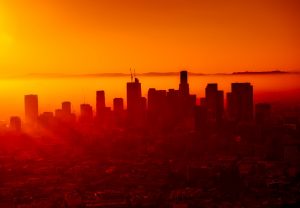Two of the terms I’ve heard on a consistent basis in the regulatory and compliance industry have been particulate matter (PM) and dust. I personally have had a little confusion with the two terms as they have been interchangeable in some situations but not in others. With today’s post, I want to dive into particulate matter and dust and analyze the differences.
The Environmental Protection Agency (EPA) clearly defines PM as a mixture of solid particles and liquid droplets found in the air. The EPA splits PM into two categories, 10 micrometers and 2.5 micrometers. PM10 is defined as inhalable particles with diameters below 10 micrometers, and PM2.5 is defined as fine inhalable particles with diameters below 2.5 micrometers. For reference, a single piece of human hair is about 70 micrometers and the human eye cannot see particles smaller than about 40 micrometers.
Particulate matter can be created by many different sources with some of the most common being construction sites, unpaved roads, complex chemical reactions, and smokestacks. The EPA strictly regulates PM like the othercriteria air pollutantsbecause of the danger to public health.
PM10 can get deep into your lungs and bloodstream, potentially causing serious health problems. PM2.5 is responsible for haze or reduced visibility in many parts of the country. California, for example, contains some of the worst smog levels in the country. Three counties in California, Los Angeles, Bakersfield, and Madera, have the worst smog levels in the country and eight of the ten top cities in the U.S. with the highest concentrations of PM2.5 are in.

A spike is defined as a time when PM2.5 concentration rises above the limit set by the EPA for acceptably healthy air. California, unfortunately, also contains 6 of the top 10 cities in the U.S. for spikes. Bakersfield, in particular, is the most polluted city in America in terms of spikes and PM concentrations. This is aided by a high volume of oil and gas operations in the California Central Valley, where Bakersfield resides.
While PM is clearly defined, dust is a little more ambiguous. It has been used interchangeably by both air quality professionals and those outside the air quality community, however, they should not be interchangeable. All PM can be considered dust, however, not all dust can be considered PM. Dust consists of particles of all size, but particles above 10 micrometers in diameter do not pose a significant health risk as they are not inhalable. They are, however, more likely to be visible to the public.
It is not uncommon for site managers to receive complaints about pollution because of visible dust around their facility without PM monitors detecting anything. This problem should not be compounded by using the two terms interchangeably as one is regulated while one is not, and it is important to know the difference. This is especially important in areas like California’s Central Valley where PM levels have been consistently high.
The team at RECES is committed to providing the knowledge and expertise to navigate the sea of environmental regulations. If you have questions or comments regarding PM or any of the other criteria air pollutants, please feel free to contact Kevin Moin by email at kmoin@reces-llc.com or by phone at (281) 529-5087.
